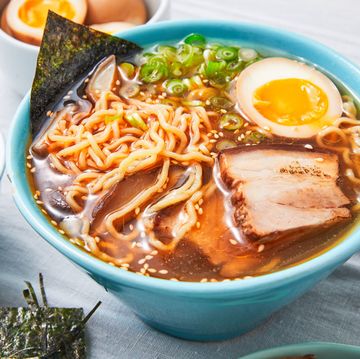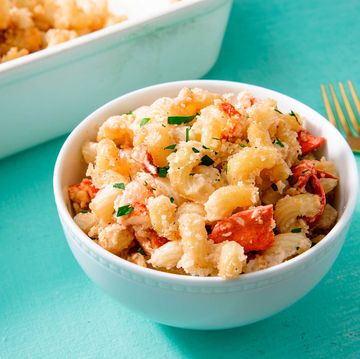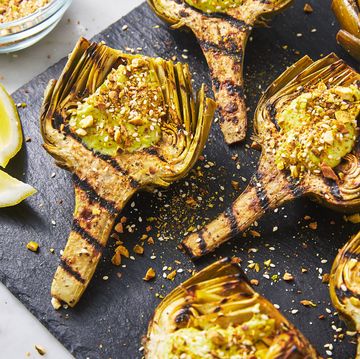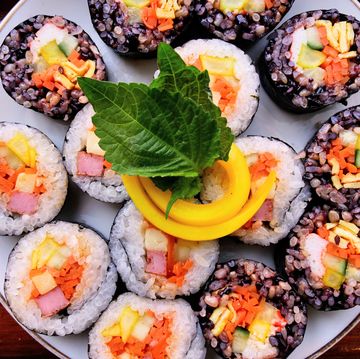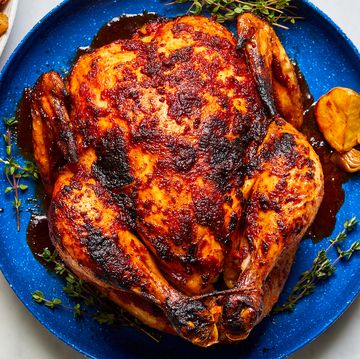
Yields:
6
Prep Time:
10 mins
Total Time:
1 hr 20 mins
If you love rice, onigiri is a must-try: a humble rice ball accented by a variety of fillings, wrapped in roasted seaweed (nori), and perfect for snacking or a light meal. Onigiri is open to customization and experimentation—fillings popular in Japan include fish roe, karaage (small pieces of fried chicken), various veggies, and grilled beef.
Below, we give three different filling options: miso salmon, spicy tuna, and umeboshi (pickled plum) dotted with furikake (a variety of Japanese seasoning mixes). You can stuff whatever your heart desires inside each ball, or, simply mix the rice with your favorite seasonings to create a super flavorful rice ball. It's the perfect cooking project to do with the whole family.
The type of rice
Because the heart and soul of onirigi is the rice, the quality of your grain is super important here. Go with the good stuff, Japanese varieties are definitely preferred. Short grain white rice gives you the proper amount of stickiness for a cohesive rice ball. You can substitute brown rice, but I’d recommend glutinous brown rice for a better hold—the longer the grain, the looser the hold, the crumblier your rice ball will be, which is something you definitely don't want in this application!
There are two types of starches in rice: amylose and amylopectin. Amylose content is higher in long grain rice and amylopectin content is higher in short grain rice and glutinous rice. Amylopectin is responsible for the desirable stickiness that we need for our onigiri: During the cooking process, the starch granules burst and gelatinize, creating a tackiness in the rice that is crucial to holding the signature triangular shape we want our onigiri to stay in.
Cooking the rice
Be sure to soak your rice in water for at least 30 minutes prior to cooking. There are two ways to cook your rice. Boiling the rice directly in the pot with an almost 1:1 ratio of rice to water is the traditional method. This yields a soft, creamy, tender rice kernel that is perfect for eating straight or for forming into onigiri.
The second method, which is the one we used in our video and in the instructions below, is a much more experimental technique that's more often used in Thai cooking to make glutinous, sticky rice: The soaked rice is placed in a steamer basket (or a fine-mesh strainer) and cooked over a pot of boiling water. Because the rice never touches the water directly, this method yields a much more al dente grain of rice: bouncier and chewier than traditional onigiri rice is. The choice is yours!
If you made your rice using the second method and find that the grains are too al dente, worry not, you can make it softer! With the rice still in the strainer, pour about 1/2 cup of boiling water evenly over the rice, then use a spoon to thoroughly stir the rice and distribute the water (any excess water will drain right into the pot below!). Clamp on the lid to your pot and bring the water to a boil again; steam the rice for another 5 minutes. With the added water content and steam action, your rice should be much softer now!
The filling
For ease, the recipe below uses canned salmon for the miso salmon mixture. You can just as well use fresh salmon! Or, if you have any leftover baked salmon, feel free to jazz that up with a little miso and use that instead. Onigiri is a great vehicle to repurpose leftovers of all kinds. Get experimental! Stuff it with pulled pork, diced garlic butter mushrooms, spicy Korean fried chicken, or super crispy bacon.
Eat as soon as possible!
Shaped by lightly salted and dampened hands, onigiri is a way to temporarily preserve rice at room temperature. It is best when eaten fresh right after shaping. To preserve the moisture in the rice for a little while longer, you can tightly wrap each rice balls individually in plastic wrap.
Rice starch tends to harden when refrigerated, which is why chilled rice always tastes starchy and chalky. If you must, onigiri can be kept in the fridge, wrapped in plastic wrap, for 1 to 2 days. To reheat, unwrap each onigiri and sprinkle a tablespoon of water on top, cover with a damp paper towel, and microwave until rice is steaming hot, about 2 to 3 minutes. (Let stand a minute before eating, to avoid burning yourself!)
If you've made this recipe, let us know down below in the comments how you liked it!
Advertisement - Continue Reading Below
Ingredients
For the steamed rice
- 2 cups
short-grain white rice
- 2 1/3 cups
water
For the miso salmon
- 1 Tbsp.
grapeseed oil
- 1
(14.75-oz.) can salmon, drained
- 1 tsp.
low-sodium soy sauce
- 1 Tbsp.
miso
For the spicy tuna
- 1
(5-oz.) can tuna, drained
- 2 Tbsp.
mayo, preferably Kewpie
- 1 tsp.
shichimi togarashi
Pinch kosher salt (optional)
For the umeboshi and furikake
- 1 cup
cooked short-grain white rice
- 1 Tbsp.
furikake
- 1
umeboshi, pitted, halved
For garnishing
Nori
Black sesame seeds
White sesame seeds
Directions
For the steamed rice
- Step 1In a large bowl, rinse rice repeatedly until water runs mostly clear, about three to five changes of water. Fill bowl with fresh water and let rice soak 30 minutes to 2 hours, up to overnight. Drain.
- Step 2For soft, tender rice: In a medium pot over medium heat, bring soaked rice and water to a boil. Cover pot with lid, reduce heat to low, and cook until rice is tender and all of the water is absorbed, 15 to 18 minutes. Remove from heat and keep covered for another 10 minutes.
- Step 3Alternatively, for al dente rice: Fill a pot with 2" of water. Place drained, soaked rice in a steamer or fine-meshed sieve that fits tightly over your pot and cover pot with lid. Over medium heat, bring water to a boil. Reduce heat to low and continue cooking until rice grains turn from opaque to translucent, about 25 minutes. Remove from heat and keep covered for another 10 minutes.
- Step 4Remove lid, fluff rice gently with a fork and let cool briefly until comfortable enough to handle.
For the miso salmon onigiri
- Step 1In a small bowl, combine soy sauce and miso until smooth.
- Step 2In a skillet over medium heat, heat oil. Add salmon and cook until golden on one side, 4 to 5 minutes. Flip and brush half the miso mixture over salmon evenly. Continue cooking until second side of fish is golden, then flip once more and brush on remaining miso mixture. Remove from heat immediately and transfer to a bowl.
- Step 3Using two forks, flake and shred salmon.
- Step 4Make onigri: Dampen hands with water and rub a tiny pinch of kosher salt between your palms. Place ½ cup warm cooked rice in the middle of your palm and pat into a circle to cover your palm. Place 1 tablespoon salmon mixture in the middle of the rice, then place about 2 tablespoons more rice on top of salmon. Bring bottom portion of rice up to meet the top portion, sealing the filling securely inside the rice. Loosely shape rice into a ball, then form a 45° angle with your thumb and index finger to mold ball into a triangular prism.
- Step 5If desired, wrap with a sheet of nori and sprinkle with sesame seeds.
For the spicy tuna onigiri
- Step 1In a medium bowl, mix together all ingredients until evenly combined.
- Step 2Make onigri: Dampen hands with water and rub a tiny pinch of kosher salt between your palms. Place ½ cup warm cooked rice in the middle of your palm and pat into a circle to cover your palm. Place 1 tablespoon tuna mixture in the middle of the rice, then place about 2 tablespoons more rice on top of tuna. Bring bottom portion of rice up to meet the top portion, sealing the filling securely inside the rice. Loosely shape rice into a ball, then form a 45° angle with your thumb and index finger to mold ball into a triangular prism.
- Step 3If desired, wrap with a sheet of nori and sprinkle with sesame seeds.
For the umeboshi and furikake onigiri
- Step 1In a medium bowl, mix together rice and furikake until well combined.
- Step 2Make onigri: Dampen hands with water and rub a tiny pinch of kosher salt between your palms. Place ½ cup warm cooked rice in the middle of your palm and pat into a circle to cover your palm. Place a piece of umeboshi in the middle of the rice, then place about 2 tablespoons more rice on top. Bring bottom portion of rice up to meet the top portion, sealing the filling securely inside the rice. Loosely shape rice into a ball, then form a 45° angle with your thumb and index finger to mold ball into a triangular prism.
- Step 3If desired, wrap with a sheet of nori and sprinkle with sesame seeds.
Advertisement - Continue Reading Below
Advertisement - Continue Reading Below
Advertisement - Continue Reading Below




